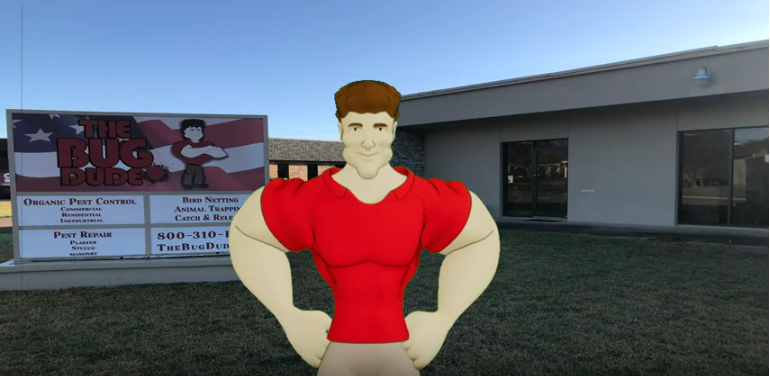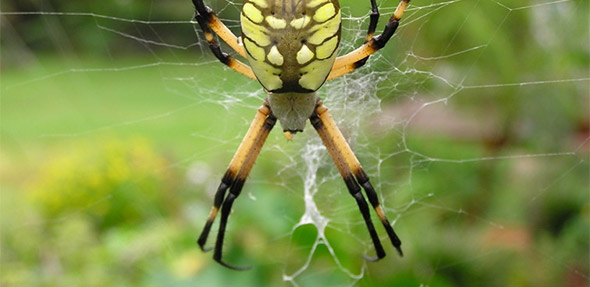The presence of spiders in and around the home is a common trigger for homeowners to schedule pest control in Fort Worth. There have been estimates of a thousand known species of spiders in Texas. While arachnologists say there is no need to call for treatment of non-threatening spiders, we understand that few persons want spiders in their home. Give us a call for professional pest control in Fort Worth. Some of the non-poisonous spiders commonly seen in and around our homes are:
Agelenopsis spp. (Grass Spiders)
As members of the funnel weaver family Agelenidae, grass spiders spin dense, sheet like webs with a funnel type retreat where they hide.
The cephalothorax is pear shaped, with two dark stripes running the full length. The abdomen is an elongated oval. Legs are spiny and hairy with a mottled appearance.
Agelenopsis is typically found on funnel webs among the grass, in the corners of buildings and other man-made structures. The spider spends most of its time in its funnel-like retreat, except for when waiting for prey. Males will leave the web at night to hunt, and can enter the home.
The Bug Dude will provide professional pest control in Fort Worth for the treatment of your home of spiders and/or other pests.
Argiope aurantia (Black and Yellow Garden Spider)
Often called a Garden Spider, and a Golden Orb Weaver, the female of the species can grow to enormous sizes, up to 28 mm, almost 3 inches! They spin an orb web with a zigzag band.
Body
Abdomen is semi oval shape, while the carapace is silver or white. The pattern on the top of the abdomen is black and yellow, while the underside is mottled black with two vertical, parallel yellow stripes. The adult male typically sports shades of brown and is considerably smaller than the female.
Legs are long with front two pairs of legs directed forward, while the rear two pairs of legs are directed backwards. Each distal leg tip has 3 claws. Common in forest edges, gardens, fallow fields, farms and orchards. The spiders prey are insects caught in the web, though they will occasionally capture lizards. These spiders seldom enter the home, though they may build nests between trees, and shrubs and the home’s walls. Contact The Bug Dude for professional pest control in Fort Worth to rid your home and property of pests.
Castianeira longipalpa (Ant Mimic Spider)
The Ant Mimic Spider is a distinctly patterned wandering hunter, catching prey at night and during the day. Their movements often mimic the carpenter ant, earning them the nickname “antmimic.”
Body
The abdomen is an elongated oval, typically brown, black, or dark red, with stripes of white or yellow hairs. The carapace is pear-shaped with a base color of black, brown, or dark red, though it is typically covered in white or yellow hairs. The legs are spiny, especially on the back legs, which are the longest. Two claws are located at the tips of the legs.
Typically lives in locations close to the ground in leaves, under rocks and logs. Habitat may also be close to, or in buildings. This spider is a hunter chasing its prey down and subduing it. If pests are a problem in your home, contact The Bug Dude for professional and effective pest control in Fort Worth.
Cheiracanthium mildei (Longlegged Sac Spider)
The Longlegged Sac Spider is pale green, tan, or yellow night hunter with very long front legs. Originally a native to southern Europe, this spider migrated to North America, where it has become fairly widespread. It is typically found indoors, where it prowls at night, looking for prey or mates.
Body
The cephalothorx and abdomen are about the same size. The abdomen in oval in shape. Legs are long relative to the body size. The legs have 2 claws.
In the United States, its territory are the walls and ceilings of houses. The spider does not spin a web, though it does spin a bed where it rests during the day. The Longlegged sac spider hunts at night. The Bug Dude’s professionals can provide the pest control in Fort Worth that you need to rid your home of pests.
Dolomedes tenebrosus (Dark Fishing Spider)
This spider is a large arachnid typically seen on tree trunks, fence posts, or the exterior walls of buildings, typically at night. They do not spin webs to capture prey, but ambush large insects, and occasionally minnows that come within striking distance when located near water.
The cephalothorax and abdomen are about equal in size, with the abdomen rounded in the front, and tapered towards the rear. The legs are long, especially in the males in proportion to the body size. They have 3 claws at the tips of their legs.
Pholcus phalangioides (Longbodied Cellar Spider)
Also called Daddy Longlegs, though it is not the six legged arachnid who shares the same common name.
The abdomen is cylindrical and elongated. The cephalothorax is beige and has two gray markings in the center. The legs are extremely long and slender with 3 claws at the tip.
This spider prefers low light areas in homes, buildings and caves. A disorganized web is used to capture insects, including spiders larger than itself. Contact The Bug Dude for pest control in Fort Worth today.
Scytodes thoracica (Spitting Spider)
Unlike many spiders with eight eyes, Scytodes has only six. Both the cephalothorax and abdomen, are rounded and about the same size. The legs are pale and spindly, with 3 claws at the tips. This spider hunts its prey and immobilizes it by spitting a mixture of silk, glue, and venom onto it. Scytodes resides in homes on walls and ceilings, in cellars, closets, and other dark areas at night.
Though their territory is typically indoors, they can occasionally be found outdoors in close proximity to homes, as well. Contact The Bug Dude for professional pest control in Fort Worth.
If poisonous or common spiders in Texas are infesting your home, give us a call. We will inspect your home, identify the species of spider(s), and provide the appropriate pest control in Fort Worth.





